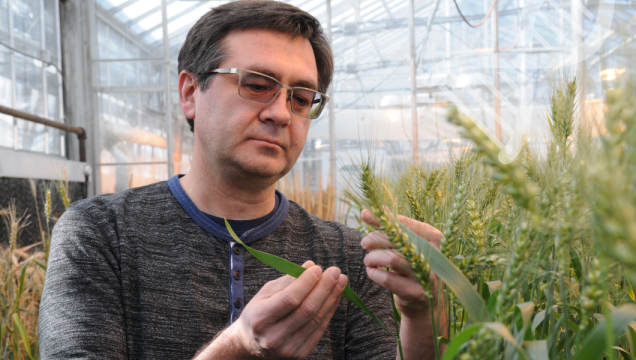For researchers at K-State’s Wheat Genetics Resource Center, it’s all about the genes. Using powerful new tools like gene editing, these scientists are taking a molecular look at how to reverse engineer nature’s “survival of the fittest” in the laboratory to improve disease resistance, increase yield and protein quality and even reduce gluten toxicity for individuals with celiac disease.
“Gene editing is essentially just another way of generating new genetic diversity in wheat or in any other crop,” said Eduard Akhunov, K-State distinguished professor of wheat genome diversity and evolution. “And genetic diversity is one of the foundations of crop improvement. Breeders are always trying to bring new genetic diversity in their breeding programs, and they achieve it using various approaches.”
Akhunov recently talked with Aaron Harries, Kansas Wheat vice president of research and operations, for an episode of the “Wheat’s on Your Mind” podcast. The pair discussed the technologies now available to speed up the wheat breeding process and how scientists are leveraging ancient genes to improve modern-day wheat.
Modifying the Wheat Genome
Akhunov and Harries discussed the differences between the tools wheat researchers now have at their disposal, including transgenics, CRISPR and more. The commonality is that they start by looking at a plant at the genetic level.
“Breeders will generally look at things like specific physical traits when they’re crossing plants to create new varieties,” Harries said. “But you’re going even smaller. You’re looking at genes.”
With transgenics, researchers are introducing a gene that is not naturally present in the plant. In the case of Bt corn, scientists introduced genes from a naturally occurring soil bacterium — Bacillus thuringiensis — into the corn genome to produce a protein that kills the larvae of the European corn borer.
For wheat, Akhunov and other researchers use a simpler, yet powerful tool to edit genomes — CRISPR-Cas9 technology. Introduced in 2012, this technology acts like molecular scissors that make incredibly precise changes to very specific places in the wheat genome. Doing so allows researchers to selectively modify very small parts of the genome to control expressed traits — like improved disease resistance.
“CRISPR editing is a precise way of modifying a specific part of the genome and leaving a small scar in the genome,” Akhunov said. “CRISPR editing provides a very diverse set of tools for modifying genome. You could remove genes; you could put in new pieces or you could precisely modify a gene to improve the trait. But in all these cases, you are not introducing something new. You are essentially using the existing genetic code, but you are just tweaking a little bit to improve traits that you are interested in.”
One example of this work is Akhunov’s work to knock out genes that negatively impact traits, like the ones that control size. When that specific regulator is knocked out, the loss of function improves the trait — in this case, increasing grain size by 10 to 20 percent. First identified in rice, this same gene found in wheat, called GW2, not only increases kernel size and plumpness but also improves protein content.
Identifying the exact function of a gene like GW2 is critical to the success of this work, especially since most genes in wheat have at least three copies in the genome — all of which have to be edited to have the highest effectiveness.
“Gene editing is focused on modifying individual genes and knowing the structure of the gene, where it is, and how many copies of the gene you have,” Akhunov said. “It’s actually quite important to have precise genetic information about individual wheat varieties.”
Just like GW2, this means researchers can access genetic information from other crops accumulated over decades of research. The comparison of this genomic data allows researchers to compare the genes between different crops. Instead of transplanting a gene from rice, sorghum or corn to achieve an outcome, it’s knowledge that is transferred from researcher to researcher. Scientists like Akhunov can then use genetic sequencing to identify if those same genes are present in the wheat genome. If the genes are present independently in both crops, then researchers can make the same tweaks to those genes to see if they produce the same effect in wheat.
“The comparison of the genomic data now available for all these crops allows us to compare across the species and identify identical genes among the crops,” Akhunov said. “I can use the information collected by my colleagues from other crop communities to transfer that into wheat and then try to modify the gene using CRISPR technology. And in many cases, it turned out that the genes that we modify have similar effects or affect the same trait that was characterized and studied in other crops.”
Researchers are using a similar sequence-and-test process to identify genes and traits from wild wheat relatives that could improve commercial wheat varieties. The Wheat Genetics Resource Center maintains a gene bank of more than 2,500 wheat accessions and 2,200 cytogenetic stocks — a collection of seeds from wild relatives of bread wheat along with historic and modern wheat breeding lines.
Before genetic sequencing and CRISPR technology, scientists would have to make crosses between wild relatives and modern wheat — made difficult because of a gene that prevents this exact process from happening in the wild. Successful crosses would then have not just one small piece transferred from one to the other, but large amounts of genetic material — all of which would have to be grown and tested for desirable outcomes in the laboratory or the field.
Genetic editing tools substantially decrease the difficulty and time required to make these crosses. Researchers can more quickly screen wild relatives for genes that affect disease resistance, quality, yield or adaptation to drought stress or heat stress. Then researchers can test whether those same genes are present in modern wheat lines or if they can be molecularly adjusted with CRISPR technology to achieve those same traits. While these lines are not yet available, promising results are just on the horizon.
“Applying gene editing technology for improving disease resistance is probably quite straightforward,” Akhunov said. “For example, there are genes that are called so-called susceptibility genes that make wheat more susceptible to disease. And by applying gene editing, it’s quite easy to remove these genes from the wheat genome, which will make plants resistant. And this is happening now, and there are a number of projects that are moving in that direction. So, for that specific trait, we’ll probably see results very soon.”
Equally as promising for consumers, researchers have successfully used CRISPR-Cas9 to reduce the presence of two types of gluten-coding genes called gliadins that are known to be abundant in immunoreactive peptides — the amino acid building blocks that form proteins. In simpler terms, researchers are unlocking how to lessen the adverse effects of gluten for those with celiac or other autoimmune diseases. When these gluten-coding genes were edited, Akhunov and his team were able to reduce the immunotoxicity caused by gliadin genes in wheat by 47-fold, while not sacrificing bread-making quality.
“What it means for people with celiac disease in its severe form, of course, we would certainly not recommend using this flour and say that it is safe for celiac patients,” Akhunov said. “But it is an important step forward. We could substantially, dramatically decrease their immunotoxicity.”
Whether researchers are looking to improve agronomic traits, apply what colleagues have learned by working with other crops, test for similar traits in wild relatives or even reduce toxicity, there is no doubt that scientists like Akhunov are still unlocking the potential of what technology like CRISPR will provide to wheat farmers, millers, bakers and consumers.
“That’s a question that we’ll be answering for the next decade or so — what we could achieve and what we cannot,” Akhunov said. “But we should consider CRISPR-Cas9 as a very powerful tool in the hands of scientists. And then I believe in the future, we could apply quite complex gene editing strategies and then modify multiple genes at the same time and achieve something that we cannot imagine now.”
Listen to the full discussion with Akhunov or learn more about other research funded in part by Kansas wheat farmers through the state wheat checkoff by checking out other episodes of “Wheat’s on Your Mind” at kswheat.com/podcast.



